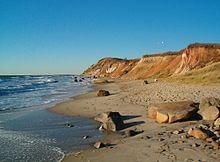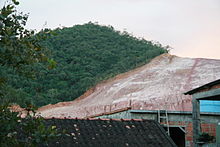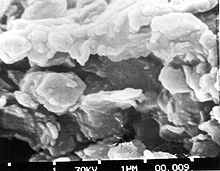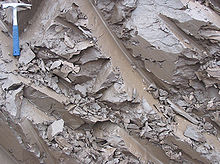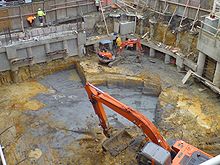- Clay
-
Clay is a general term including many combinations of one or more clay minerals with traces of metal oxides and organic matter.[1] Geologic clay deposits are mostly composed of phyllosilicate minerals containing variable amounts of water trapped in the mineral structure.
Contents
Formation
Deforestation for clay extraction in Rio de Janeiro city - Brazil. The picture is of Morro da Covanca - Jacarepaguá.
Clay minerals are typically formed over long periods of time by the gradual chemical weathering of rocks, usually silicate-bearing, by low concentrations of carbonic acid and other diluted solvents. These solvents, usually acidic, migrate through the weathering rock after leaching through upper weathered layers. In addition to the weathering process, some clay minerals are formed by hydrothermal activity. Clay deposits may be formed in place as residual deposits in soil, but thick deposits usually are formed as the result of a secondary sedimentary deposition process after they have been eroded and transported from their original location of formation. Clay deposits are typically associated with very low energy depositional environments such as large lakes and marine deposits.
Primary clays, also known as kaolins, are located at the site of formation. Secondary clay deposits have been moved by erosion and water from their primary location.[2]
Definition
Clays are distinguished from other fine-grained soils by differences in size and mineralogy. Silts, which are fine-grained soils that do not include clay minerals, tend to have larger particle sizes than clays, but there is some overlap in both particle size and other physical properties, and there are many naturally occurring deposits which include silts and also clay . The distinction between silt and clay varies by discipline. Geologists and soil scientists usually consider the separation to occur at a particle size of 2 µm (clays being finer than silts), sedimentologists often use 4-5 μm, and colloid chemists use 1 μm.[1] Geotechnical engineers distinguish between silts and clays based on the plasticity properties of the soil, as measured by the soils' Atterberg Limits. ISO 14688 grades clay particles as being smaller than 2 μm and silts larger.
Grouping
Depending on the academic source, there are three or four main groups of clays: kaolinite, montmorillonite-smectite, illite, and chlorite. Chlorites are not always considered a clay, sometimes being classified as a separate group within the phyllosilicates. There are approximately 30 different types of "pure" clays in these categories, but most "natural" clays are mixtures of these different types, along with other weathered minerals.
Varve (or varved clay) is clay with visible annual layers, formed by seasonal differences in erosion and organic content. This type of deposit is common in former glacial lakes. When glacial lakes are formed there is very little movement of the water that makes the lake, and these eroded soils settle on the lake bed. This allows such an even distribution on the different layers of clay.[2]
Quick clay is a unique type of marine clay indigenous to the glaciated terrains of Norway, Canada, Northern Ireland, and Sweden. It is a highly sensitive clay, prone to liquefaction, which has been involved in several deadly landslides.
Historical and modern uses
Clays exhibit plasticity when mixed with water in certain proportions. When dry, clay becomes firm and when fired in a kiln, permanent physical and chemical changes occur. These reactions, among other changes, cause the clay to be converted into a ceramic material. Because of these properties, clay is used for making pottery items, both utilitarian and decorative. Different types of clay, when used with different minerals and firing conditions, are used to produce earthenware, stoneware, and porcelain. Prehistoric humans discovered the useful properties of clay, and one of the earliest artifacts ever uncovered is a drinking vessel made of sun-dried clay.[citation needed] Depending on the content of the soil, clay can appear in various colors, from a dull gray to a deep orange-red.
Clay tablets were used as the first known writing medium, inscribed with cuneiform script through the use of a blunt reed called a stylus.
Clays sintered in fire were the first form of ceramic. Bricks, cooking pots, art objects, dishware, and even musical instruments such as the ocarina can all be shaped from clay before being fired. Clay is also used in many industrial processes, such as paper making, cement production, and chemical filtering. Clay is also often used in the manufacture of pipes for smoking tobacco. Until the late 20th century bentonite clay was widely used as a mold binder in the manufacture of sand castings.
Clay, being relatively impermeable to water, is also used where natural seals are needed, such as in the cores of dams, or as a barrier in landfills against toxic seepage (lining the landfill, preferably in combination with geotextiles).[3]
Recent[when?] studies have investigated clay's absorption capacities in various applications, such as the removal of heavy metals from waste water and air purification.
Medical and agricultural uses
A traditional use of clay as medicine goes back to prehistoric times. An example is Armenian bole, which is used to soothe an upset stomach, similar to the way parrots (and later, humans) in South America originally used it.[4] Kaolin clay and attapulgite have been used as anti-diarrheal medicines.
Clay as a building material
Clay is one of the oldest building materials on Earth, among other ancient, naturally-occurring geologic materials such as stone and organic materials like wood. Between one-half and two-thirds of the world's population, in traditional societies as well as developed countries, still live or work in a building made with clay as an essential part of its load-bearing structure. Also a primary ingredient in many natural building techniques, clay is used to create adobe, cob, cordwood, and rammed earth structures
See also
- Bentonite
- Ceramic
- Clay (industrial plasticine)
- Clay animation
- Clay court
- Clay pit
- Geophagy (eating of soils, including eating of clay)
- Expansive clay
- Graham Cairns-Smith, proposed the 'clay theory' of abiogenesis
Footnotes
- ^ a b Guggenheim & Martin 1995, pp. 255–256
- ^ a b Environmental Characteristics of Clays and Clay Mineral Deposits - USGS
- ^ Koçkar, Mustafa K.; Akgün, Haluk; Aktürk, Özgür, Preliminary evaluation of a compacted bentonite / sand mixture as a landfill liner material (Abstract). Department of Geological Engineering, Middle East Technical University, Ankara, Turkey
- ^ Evolutionary biology: Dirty eating for healthy living by Jared M. Diamond
References
- Guggenheim, Stephen; Martin, R. T. (1995), "Definition of clay and clay mineral: Journal report of the AIPEA nomenclature and CMS nomenclature committees", Clays and Clay Minerals 43 (2): 255–256, doi:10.1346/CCMN.1995.0430213, http://www.clays.org/journal/archive/volume%2043/43-2-255.pdf
- Clay mineral nomenclature American Mineralogist.
- Ehlers, Ernest G. and Blatt, Harvey (1982). 'Petrology, Igneous, Sedimentary, and Metamorphic' San Francisco: W.H. Freeman and Company. ISBN 0-7167-1279-2.
- Hillier S. (2003) Clay Mineralogy. pp 139–142 In: Middleton G.V., Church M.J., Coniglio M., Hardie L.A. and Longstaffe F.J.(Editors) Encyclopedia of sediments and sedimentary rocks. Kluwer Academic Publishers, Dordrecht.
External links
- Building the Phyllosilicates University of New Hampshire
- The Clay Minerals Group of the Mineralogical Society
- Clay Whistles
- Information about clays used in the UK pottery industry
- The Clay Minerals Society
- Plasticity of clay
- Organic Matter in Clays
Topics in geotechnical engineering Soils Soil properties Soil mechanics Geotechnical investigation Laboratory tests Field tests Foundations Bearing capacity · Shallow foundation · Deep foundation · Dynamic load testing · Pile integrity test · Wave equation analysis · Statnamic load testRetaining walls Slope stability Earthquakes Geosynthetics Instrumentation for Stability Monitoring Categories:- Types of soil
- Sculpture materials
- Ceramic materials
- Natural materials
- Sedimentology
- Sediments
- Phyllosilicates
Wikimedia Foundation. 2010.

